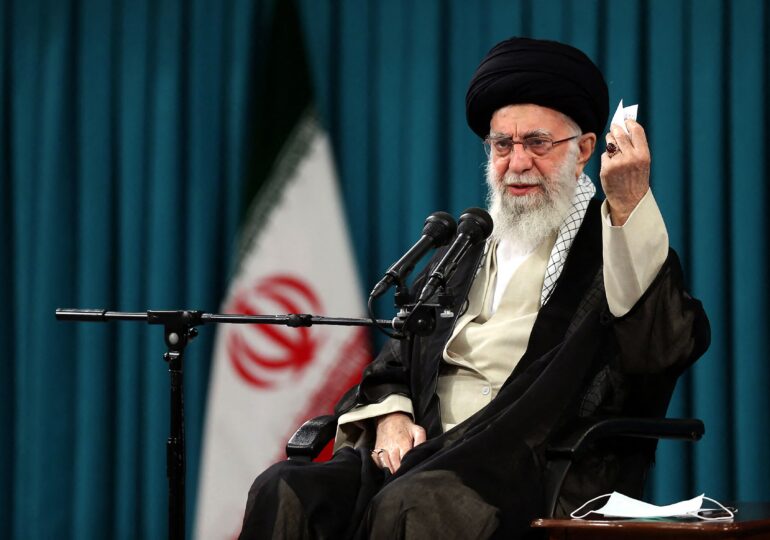President Donald Trump declared on Tuesday that the United States knows the whereabouts of Iran’s supreme leader, Ayatollah Ali Khamenei, but added that the US will not kill him, „at least for now,” and demanded the „unconditional surrender” of Iran.
Ayatollah Ali Khamenei has spent nearly four decades as the supreme leader of Shiite Iran, building a regional power to rival Sunni Gulf states and relentlessly hostile towards the US and Israel, while crushing repeated uprisings in the country, Reuters writes.
Initially considered weak and an unlikely successor to the charismatic Ayatollah Ruhollah Khomeini, the founder of the Islamic Republic, Khamenei gradually consolidated his power, becoming the undisputed leader of Iran.
In the beginning, Khamenei lived in the shadow of his mentor, Khomeini. Struggling to establish his religious authority, he instead built a formidable security apparatus to expand his power.
Unchallenged in the position of supreme leader, he dominated the country's successive elected presidents and promoted nuclear technology, unsettling the surrounding region.
- Where would Iran's supreme leader hide in times of war. Who forbade Israel to eliminate Ali Khamenei
However, since Hamas, supported by Tehran, attacked Israel on October 7, 2023, Khamenei's regional influence has weakened as Israel has targeted Iran's allies – from Hamas in Gaza to Hezbollah in Lebanon, the Houthi group in Yemen, and militias in Iraq. And Iran's close ally, the autocratic president of Syria, Bashar al-Assad, was ousted from power at the end of last year.
Compromises have kept him in power
At 86 years old, Khamenei has been in power since 1989 and holds supreme authority over all branches of government, military, and judiciary. While elected officials handle day-to-day affairs, no major policy – especially those involving the United States – can be implemented without his explicit approval.
His leadership style combines ideological rigidity with strategic pragmatism. He is deeply skeptical of the West, especially the US, which he accuses of seeking regime change. However, he has shown willingness to make concessions when the survival of the Islamic Republic is at stake.
The concept of "heroic flexibility," first mentioned by Khamenei in 2013, allows for tactical compromises to achieve objectives, reflecting Khomeini's decision in 1988 to accept a ceasefire after eight years of war with Iraq.
Khamenei's cautious approval of the 2015 nuclear deal between Iran and six world powers was another such moment, as he calculated that lifting sanctions was necessary to stabilize the economy and consolidate power.
He faced the same dilemma in March when Trump revealed he had sent a letter to Khamenei to discuss a new nuclear pact and warned of military action if diplomacy fails to curb Tehran's nuclear ambitions.
Tehran maintains that the program is purely peaceful, but the West suspects clandestine weapon development, while Israel views it as an existential threat.
Trump abandoned the 2015 deal during his first term in 2018 and reimposed severe sanctions on Iran. Tehran responded by gradually violating all agreed restrictions on its nuclear program.
The supreme leader's response was, as usual, scathing: "Hostility from the US and Israel has always existed. They threaten us with attacks, which we do not consider very likely, but if they commit any wrongdoing, they will certainly receive a strong reciprocal blow," Khamenei promised.
"And if they think of provoking riots within the country, as they have done in past years, the Iranian people themselves will deal with them," he added.
He cultivated a loyal security structure
Khamenei has long sought to ensure that no group, not even his closest allies, will accumulate enough power to challenge him and his anti-American stance.
Without the religious credibility of Khomeini, he repeatedly turned to his sophisticated security structure, the Islamic Revolutionary Guard Corps (IRGC) and Basij, a religious paramilitary force composed of hundreds of thousands of volunteers, to suppress dissent.
His power largely stems from the parastatal financial empire known as Setad, valued at tens of billions of dollars, which is directly under Khamenei's control and has grown immensely during his leadership.
Billions of dollars have also been invested in the Revolutionary Guard over decades to help bolster Shiite militias in Iraq, Lebanon, and Yemen, and support Assad in Syria.
They were the ones who quashed the protests that erupted after Mahmoud Ahmadinejad's reelection as president in 2009 amid allegations of electoral fraud. Khamenei supported him, though he was later offended by Ahmadinejad's unchecked ambition.
In 2022, Khamenei was equally ruthless in arresting, imprisoning, or sometimes executing protesters outraged by the death of young Iranian-Kurdish woman Mahsa Amini.
He survived an assassination attempt
Experts outside Iran describe him as a secretive ideologue, fearful of betrayal, an anxiety fueled by an assassination attempt in June 1981 that paralyzed his right arm.
According to his official biography, Khamenei himself was subjected to severe torture in 1963 when, at the age of 24, he endured the first of a series of prison sentences for political activities under the Shah's regime.
After the revolution, as deputy defense minister, Khamenei grew close to the Revolutionary Guards during the war with Iraq from 1980-1988, which claimed a million lives on both sides.
He ascended to the presidency with Khomeini's support and was a surprising choice as Khomeini's successor, given that he lacked both Khomeini's popularity and superior clerical qualifications.
Karim Sadjadpour, from the Carnegie Endowment for International Peace, says that "a quirk of history" transformed a "weak president into an initially weak supreme leader, then into one of the top five most powerful Iranians of the past 100 years."

